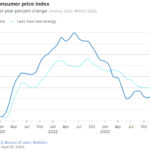Rents jumped nationwide over the past year, but these big U.S. cities remain comparatively affordable for apartment dwellers.
Not that it's easy.
The housing market might be cooling off a bit these days, but average home prices are still substantially higher than they were a year ago. Rents have risen too, and only at a slightly slower pace.
Put it all together and the perennial question of renting vs. buying(opens in new tab) is as pressing as ever.
It's an especially tough conundrum for retirees(opens in new tab) wishing to relocate, young professionals(opens in new tab) looking to put down roots, or would-be remote workers(opens in new tab). Heck, it's an issue for anyone who doesn't have quite the financial wherewithal to come up with a down payment – to say nothing of closing costs, insurance payments, property taxes(opens in new tab), maintenance expenditures … the list of outlays goes on and on.
But first things first. The housing market(opens in new tab) remains tough. Despite entering a downtrend over the summer of 2022, single-family home prices are still up 9.2% on a year-over-year basis, according to the S&P CoreLogic Case-Shiller U.S. National Home Price Index(opens in new tab).
Mortgage rates(opens in new tab) have spiked even more. The average rate on a 30-year fixed-rate mortgage(opens in new tab) has been hovering in the mid-6% range, per Freddie Mac. That compares to around 3.5% a year ago.
Naturally, renters are getting pinched too. According to the Bureau of Labor Statistics, average rents for urban consumers are up about 8% year-over-year.
That's what happens when the Federal Reserve is aggressively hiking interest rates(opens in new tab) in a bid to whip the worst inflation(opens in new tab) in four decades.
Given this economic reality, it seemed a good time to search for large, cosmopolitan urban areas that also happen to sport the cheapest apartment rents. To do so, we turned to data from the Council for Community and Economic Research (C2ER)(opens in new tab) Cost of Living Index.
C2ER surveys prices for hundreds of goods and services in 265 census-designated areas, both large and small. For the purposes of our survey, we limited ourselves to cities with metro populations of at least 1 million, per the U.S. Census Bureau's list of core-based statistical areas.
With that methodology in place, we were able to find the biggest U.S. cities with the cheapest apartment rents. Note that the rents listed below are for the cities at the center of the metro areas we surveyed. These rents offered the steepest discounts to the national average for apartments of all types ($1,427 per month), according to C2ER data. Cities are listed in order of highest to lowest rent.
10. Houston, Texas
- Metro population: 7,206,841
- Median household income: $70,893 (U.S.: $69,717)
- Average apartment rent: $1,349 (U.S.: $1,427)
The Houston metropolitan area, which includes The Woodlands and Sugar Land, is home to more than 7 million people, making it the fifth largest metro area in the U.S. Yet despite its gargantuan size, the city of Houston proper (pop. 2.3 million) boasts some of the cheapest apartment rents among metro areas with at least 1 million residents.
The average monthly rent for apartments of all sizes in Space City is actually 5.5% lower than the national average. That's a steal when you consider how much the city and surrounding area have to offer.
On the cultural front, attractions range from the Houston Museum of Fine Arts(opens in new tab) to Space Center Houston(opens in new tab) to the Houston Symphony(opens in new tab), one of the nation's top orchestral ensembles. Sports fans can root for Houston's six professional major league teams. Throw in the wide variety of restaurants and nightlife options – not to mention the metro area's diversity of peoples and cultures – and Houston's cosmopolitan bona fides cannot be denied.
It should be noted, however, that two factors help tamp down rents in the city of Houston proper: a comparatively low median household income of $56,019; and a city poverty rate of 19.5%, which is about 1.4 times the Texas state rate of 14%.
9. Pittsburgh, Pennsylvania
- Metro population: 2,353,538
- Median household income: $66,609
- Average apartment rent: $1,322
Pittsburgh is probably best known to the rest of the nation for its professional sports teams – the NFL's Steelers, the MLB's Pirates and the NHL's Penguins – and for its Rust Belt past.
But this metro area over the past few decades has transformed itself into a hub for healthcare(opens in new tab), tech and higher education.
Carnegie Mellon University and the University of Pittsburgh are major academic and research centers, and help funnel talent into the local operations of big tech names, such as Google parent Alphabet (GOOGL(opens in new tab)), Amazon.com (AMZN(opens in new tab)) and Microsoft (MSFT(opens in new tab)).
Meanwhile, the University of Pittsburgh Medical Center(opens in new tab) – with its 40 hospitals, 92,000 employees and more than 8,000 licensed beds – serves as an anchor for the same sort of academic and research endeavors in the healthcare field.
And those are just the headline institutions. In total, the metro area is home to 68 colleges and universities.
The city also boasts a vibrant and expansive environment for the arts. Heinz Hall, the cornerstone of the cultural district, features Broadway shows, concerts by the Pittsburgh Symphony Orchestra and other events.
Best of all, cosmopolitan living can be had at a reasonable price in the City of Bridges. At $1,322 a month, the average apartment rents for 7.3% less than the national average.
Overall housing costs, which include mortgages, rents and related expenses, are similarly discounted vs. national levels, per C2ER.
8. Minneapolis-St. Paul, Minnesota
- Metro population: 3,690,512
- Median household income: $87,433
- Average apartment rent: $1,317
Minneapolis-St. Paul offers a hip and progressive atmosphere with a midwestern(opens in new tab) sensibility – and reasonable costs of living.
The Twin Cities are known for multiple cultural outlets, pro teams in all four major sports, a host of universities and colleges, and a diverse economy. And yet the average apartment rents for $1,317 a month, or almost 8% below the U.S. average.
Those easy-on-the-wallet leases help keep overall housing costs under control too, per C2ER. Mortgages, rents and related expenses run about 9% less than what the typical American pays.
A sizable student population certainly enjoys the break on rents. In addition to the University of Minnesota, which has two campuses, the Twin Cities are home to a dozen private colleges.
The metro economy also includes government jobs, as well as businesses involved in retail, technology, medicine, finance, recreation, agriculture and manufacturing.
Heavy hitters headquartered in the metro area include 3M (MMM(opens in new tab)) and UnitedHealth Group (UNH(opens in new tab)), both of which are components of the Dow Jones Industrial Average(opens in new tab). Target (TGT(opens in new tab)) and U.S. Bancorp (USB(opens in new tab)) are just two more examples among the horde of brand-name firms calling the metro area home.
As for those aforementioned cultural outlets, highlights include Minneapolis' Guthrie Theater and the Walker Art Center. In St. Paul, there's the Ordway Center for the Performing Arts, home of the St. Paul Chamber Orchestra(opens in new tab) and the Minnesota Opera.
7. Columbus, Ohio
- Metro population: 2,151,017
- Median household income: $71,839
- Average apartment rent: $1,265
Despite being home to the state capital as well as multiple Fortune 500 corporations, Columbus has a small-town feel to go along with its small-town living costs.
Affordable costs of living – and an average apartment rent that stands 11% lower than the national average – are certainly appreciated by the students of the Ohio State University (OSU). Between undergraduate and graduate students, the academic powerhouse and research center's student enrollment in Columbus alone tops 61,000.
During football season, locals live and die by the fate of their beloved OSU Buckeyes, which is regularly one of the nation's top teams. Gridiron excitement and anxiety dominates water-cooler talk, and streets become deserted as kickoff approaches.
Happily, Columbus offers many low-cost activities year-round beyond the OSU campus. The renowned Columbus Zoo(opens in new tab) charges seniors and residents discounted admission on selected days. The Ohio State Fair, which attracts around 900,000 visitors every summer for pig races, fireworks, foods on a stick and more, is another family-friendly bargain.
And as important as OSU might be, Columbus is far from a one-horse town. The state capital means there are plenty of jobs in state government(opens in new tab), as well as in the ecosystem of related private employment that government supports. Major employers also include JPMorgan Chase (JPM(opens in new tab)), the nation's biggest bank by assets, and insurance company Nationwide, which maintains its headquarters in Columbus.
6. Cincinnati, Ohio
- Metro population: 2,261,665
- Median household income: $70,818
- Average apartment rent: $1,144
Skyline Chili's Loaded Chili Bowl(opens in new tab) is a pretty good bargain, but Cincinnati's apartment rents are arguably an even better deal. Renters in the Queen City pay an average of $1,144 a month. That's a savings of almost 20% off the national average.
But cheap rents are just part and parcel of this widespread metro area's generally low overall costs for housing. Indeed, the greater Cincinnati area, which stretches into neighboring Kentucky and Indiana, enjoys general housing expenses that run about 20% below the national average.
That's a remarkable fact considering the city's density of corporate headquarters. Indeed, seven Fortune 500 companies – including Procter & Gamble (PG(opens in new tab)) and Kroger (KR(opens in new tab)), both of which are Warren Buffett stocks(opens in new tab) – call Greater Cincinnati home.
Cheap rents also come in handy given that this metro area with more than 2.2 million people boasts all sorts of big-city events and attractions. The Ultimate Underground Queen City Tour(opens in new tab), Cincinnati Symphony Orchestra and the aforementioned Skyline Chili chain of fast-food restaurants are just a few of the offerings on hand. And then, of course, there's Cincinnati's reputation as a big-time sports town, thanks to the NFL's Cincinnati Bengals and MLB's Cincinnati Reds.
The downside of having some of the cheapest apartment rents in the nation? The city of Cincinnati proper (pop. 308,913) has a poverty rate of 27.3%, which is more than double the rate of the Greater Cincinnati metro area.
5. Buffalo, New York
- Metro population: 1,162,336
- Median household income: $62,794
- Average apartment rent: $1,046
Rents are rising in Buffalo, but they're still enough of a bargain to maintain the Nickel City's place as one of the least expensive large metro areas for apartment dwellers.
Buffalo sports an average apartment rent of $1,046 a month, or almost 27% below the national average.
The state's second-largest city is perhaps most famous as the birthplace of buffalo wings, but it has more highfalutin attractions too. The Buffalo Philharmonic Orchestra(opens in new tab), Albright-Knox Art Gallery(opens in new tab) and Shea's Buffalo Theatre(opens in new tab) are all top notch. The area is also home to the State University of New York at Buffalo, which hosts a number of major research centers. Architectural gems such as the art deco Buffalo City Hall and Frank Lloyd Wright's Martin House(opens in new tab) remind residents and tourists alike of the city's once glorious past.
And then, of course, there are the professional sports teams, most notably the NFL's Buffalo Bills and the NHL's Buffalo Sabres. True, the city gets plenty of ribbing for its rough winters, but Buffalonians insist that its location on the shores of Lake Erie and sublime summer weather more than make up for the long stretches of cold and snow.
Although this Rust Belt city has declined precipitously from its early 20th century peak, that change in fortune contributes mightily to Buffalo's affordability today. The metro area's overall housing costs, which include mortgages, rents and related expenses, are 10% lower than the national average, per C2ER. Groceries, utilities, transportation and healthcare are all significantly cheaper too.
4. St. Louis, Missouri
- Metro population: 2,806,615
- Median household income: $70,189
- Average apartment rent: $1,001
The St. Louis metro area, which spills over into neighboring Illinois, boasts big-city amenities at bargain prices.
Major league sports certainly help put the city on the national radar, but three national research universities, an extensive roster of major corporate headquarters, and an internationally known symphony orchestra place St. Louis in rare company when it comes to what residents receive with cheap apartment rents.
The city known as the Gateway to the West is home to seven Fortune 500 companies, including Centene (CNC(opens in new tab)), Post Holdings (POST(opens in new tab)) and Emerson Electric (EMR(opens in new tab)). Emerson Electric happens to be a member of the S&P 500 Dividend Aristocrats(opens in new tab), an index of S&P 500 companies that have raised their payouts for at least 25 consecutive years.
As for major academic institutions, the city is host to Saint Louis University and Washington University in St. Louis(opens in new tab).
The presence of so many major corporations and universities helps the metro area boast a median household income that's higher than the national median, and yet apartment rents still run 30% below the U.S. average.
Economic conditions at the city level aren't quite as bright, however. Median household income in the city of St. Louis proper (pop. 293,310) is roughly two-thirds that of the metro area. Meanwhile, the city's poverty rate is nearly double the metro area figure of 10.6%.
3. Birmingham, Alabama
- Metro population: 1,114,262
- Median household income: $60,725
- Average apartment rent: $1,000
Residents of Birmingham, which centers the Birmingham-Hoover metro area, enjoy below-average costs for all manner of goods and services. Whether we're talking about groceries, transportation or healthcare, folks can catch a break on loads of prices compared to what the typical American pays.
And nowhere are these savings more salient than in housing costs, which collectively run 21.2% below the national level, per C2ER. Partly that's a function of relatively affordable rents. The average apartment rents for $1,000 a month less, or a 30% discount to the national average.
At the same time, Birmingham is a commercial and educational powerhouse. Major companies calling the area home include bank holding company Regions Financial (RF(opens in new tab)); Vulcan Materials (VMC(opens in new tab)), a maker of construction materials; and healthcare provider Encompass Health (EHC(opens in new tab)). A number of major colleges of medicine, dentistry and law also boost the local economy. Taken all together, the concentration of institutions makes Birmingham a key regional business center and an important financial hub.
The metro area also serves as the cultural capital of Alabama, offering an abundance of museums and galleries, the Alabama Ballet(opens in new tab) and the Alabama Symphony Orchestra(opens in new tab).
There is, however, a flip side to cheap apartment rents: Birmingham metro's median household income is 13% below the national level. And in the city of Birmingham itself (pop. 196,410), median household income of $36,614 is even lower. Lastly, the city proper has a poverty rate of 28.3%, vs. the Alabama state rate of 16.1%.
2. Tulsa, Oklahoma
- Metro population: 1,024,191
- Median household income: $59,696
- Average apartment rent: $961
Tulsa is the first of two Oklahoma(opens in new tab) cities topping off our list. And if hearing the word Oklahoma conjures up images of covered wagons, you need to update your frame of reference in a big way.
True, this Oklahoma city traces its roots back to the Western expansion, first as a cattle town and later as the "Oil Capital of the World." Reminders can be found everywhere. The Gilcrease Museum specializes in exhibits about the American West. Another must-see is the Philbrook Museum of Art(opens in new tab). Financed by the oil boom, this historic home was turned into a museum in 1939, and has earned the moniker "the most beautiful place in Oklahoma."
Music lovers can stop in Cain's Ballroom or Tulsa Theater for live shows of country, rap and rock groups or visit the Bob Dylan Center. History buffs can visit the Greenwood Cultural Center, whose mission is to tell the legacy of Tulsa's Black Wall Street and the Greenwood district's revival. Historic Route 66 runs through it.
Those looking to enjoy the outdoors can hike or bike around the Turkey Mountain Urban Wilderness Area, which is less than a 15-minute drive from downtown. The 300-acre area is covered in woods and thick treetops and has two ponds. Turkey Mountain itself provides a scenic view of the Arkansas River, as well as a view of Tulsa from its 300-foot summit.
As much as Tulsa has to offer for everyone from retirees(opens in new tab) to remote workers(opens in new tab), high prices aren't on the list. The average apartment rents for a third less than the national average. And overall housing costs run about 27% below what the typical American pays.
1. Oklahoma City, Oklahoma
- Metro population: 1,441,647
- Median household income: $61,815
- Average apartment rent: $892
Of all U.S. metro areas with populations of more than 1 million, none has cheaper apartment rents than Oklahoma City.
The largest city in Oklahoma offers remarkably affordable prices for an urban area of its size. Whether we're talking about Oklahoma City proper (pop. 687,691) – or the greater metro area that includes Norman and Edmond – just about everything in this region is a relative bargain.
And that's especially true if you're a renter. The typical apartment in Oklahoma City goes for $892 a month, or almost 38% less than the national average. Indeed, cheap rents contribute to the city's unusually low overall housing costs, which run 27% below the national level.
Although rents and other costs might be more typical of life in a small town, Oklahoma City offers plenty of big-city attractions, from a philharmonic orchestra to the National Softball Hall of Fame and Museum(opens in new tab). The NBA's Oklahoma City Thunder represents the region on the national professional sports stage.
Thanks to its location in the heart of oil country, Oklahoma City also hosts a number of top-rated oil & gas(opens in new tab) companies. Major employers include Devon Energy (DVN(opens in new tab)), Chesapeake Energy (CHK(opens in new tab)) and Continental Resources (CLR).
Oklahoma City proper has a lower median household income ($59,214) than the metro area around it, which factors into why the city boasts some of the nation's cheapest apartment rents. OKC's poverty rate of 15.8% is also higher than the metro area rate of 14.5%.
Source: kiplinger.com












